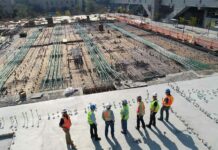It is well to be noted that in Pennsylvania, about 13% of the bridges have been identified as being deficient structurally. In order to address this issue, engineers in the state have gone ahead and employed AI so as to come up with lighter concrete blocks to make use in new construction projects. Furthermore, this innovative solution looks to curb some of the greenhouse gas emissions that are released by traffic.
In the present scenario, the federal allocation in terms of billions of dollars towards infrastructure projects looks insufficient so as to cover the extensive costs required when it comes to repairing or replacing the nation’s deteriorating scene of bridges, tunnels, buildings, and also roads. But certain engineers are looking to explore the potential of AI in order to construct more durable projects at that too at a reduced cost.
Amir Alavi, an engineering professor at the University of Pittsburgh, opines that these structures, which are equipped with the tools for disposal, go on to offer significant savings when it comes to materials, costs, and overall efficiency.
The potential for success happens to be enormous. The production of cement alone accounts for a minimum of 8% of the total worldwide carbon emissions, and the international usage of concrete amounts to 30 billion tons per year. Hence, improving the efficiency in case of concrete production would have large environmental implications.
It is worth noting that AI refers to machines that go on to possess the capability to synthesize data, pick patterns, and also draw conclusions, very similar to the human mind. The capacity of AI so as to enhance and expedite tasks, such as engineering challenges, is undoubtedly immeasurable. The system operates by evaluating large quantities of data and helping humans with improved information, models, and choices to aid decision-making.
It has the capabilities to be both cost-effective, with one machine able to execute the work of dozens of engineers, as well as creative in generating new approaches to familiar tasks.
However, experts opine against adopting the technology quickly because of a dearth of regulation and the fact that its advantages have not been widely proven. Some individuals go on to show concerns with regards to the capability of AI in order to effectively design infrastructure in a complex environment that has multiple regulators and participants in it over a period that is extended. Some people express reservations on the potential for flawed data and also results that are not reliable at all because of the fact that AI can have an access as well as utilize information from the entire internet in an instant.
In years that have gone by, the issues that happen to be faced by American infrastructure have become very apparent. Like Texas experienced a failure in the power grid because of the devastating ice storms that had hit in 2021, and the state still happens to be grappling with meeting the energy demands. Additionally, communities throughout the US, ranging right from Flint, Michigan, to Jackson, Mississippi, have had struggles with water supplies that are inadequate. Moreover, it is also evident that that there are more than 42,000 bridges that are in poor condition throughout the US.
According to professor of civil, environmental, and geodetic engineering at Ohio State University, Abdollah Shafieezadeh, a major number of the country’s roadways as well as bridges were constructed decades ago. Consequently, there are significant issues in numerous aspects of infrastructure.
The partnerships in Pennsylvania give out the potential of AI to address these issues.
Engineers in the bridge project are making use of AI technology in order to create innovative shapes in the case of concrete blocks. These new shapes happen to be designed to reduce material usage by 20% while also ensuring that durability is taken care of. According to the American Road & Transportation Builders Association, there are more than 12,000 blocks in Pennsylvania that should be repaired. The Pennsylvania Department of Transportation aims to make use of these blocks to construct a bridge.
Apparently, engineers in Pittsburgh are looking to collaborate with the Pennsylvania Turnpike Commission in order to develop an enhanced noise-absorbing wall. This innovative design is looking to enhance efficiency while at the same time capturing a part of the nitrous oxide emissions that are produced by vehicles. The area chosen for construction happens to be disproportionately affected by noise pollution from the highway. The designs are anticipated to reduce material costs by almost 30%.
As per Dr. Alavi, these novel projects have been quite successful in the lab environment, but they have not been tested yet in the field.
One of the biggest benefits of AI in civil engineering is its capability to rapidly come up with new designs. Apart from that, another major benefit is its calibre to effectively prevent and detect damage.
Instead of funding significant amounts of money when it comes to repair projects, engineers as well as transportation agencies can go on to focus on early problem detection. Like they could identify issues such as cracks forming in a bridge much before the structure becomes compromised.
Seyede Fatemeh Ghoreishi, an engineering and computer science professor at Northeastern University, says that this technology can analyze real-time events such as the bridge collapse on Interstate 95 in Philadelphia in the summer or the fire that led to the closure of a section of Interstate 10 in Los Angeles in November this year. Furthermore, it all has the capacity to be further developed to execute automated emergency responses.
But like in numerous other fields, there happen to be a significant number of discussions as well as worries with regards to the connection between AI, human labor, as well as physical safety.
Although AI has proven to be advantageous in various applications, numerous technology leaders have gone on to testify before Congress, pushing for the implementation of regulations. In October 2023, President Biden issued an executive order that had in it a variety of A.I. standards, like those related to safety, privacy, and also support for workers.
Experts are going ahead and expressing concerns with regards to the dissemination of disinformation through AI systems. AI apparently functions by incorporating existing data, and if this data that it relies on happens to be incorrect or biased, the AI will go on to produce flawed conclusions.
Dr. Jean Mattei, who is a former president of the American Society of Civil Engineers and has dedicated her career to education and ethics in engineering, expressed her belief that as progress continues, she is indeed confident that they will reach a stage where tackling such issues becomes less likely; however, they have not reached that point yet.
One more concern happens to be the absence of standards for when it comes to AI. For instance, the robotics industry has a dearth of specific standards set by the Occupational Safety and Health Administration-OSHA. There happens to be a growing concern with regards to car crashes that involve autonomous vehicles, but at the same time, it is important to note that, at present, automakers are not required to work in accordance with any federal regulations when it comes to software safety testing.
Lola Ben-Alon, who happens to be an assistant professor of architecture technology at Columbia University, executes caution when utilizing AI. She emphasized the importance of taking the time to gauge how it should be used, but clarified that she was not in any way criticizing it and did acknowledge the numerous potential benefits it happens to have.
There is a very little doubt that AI is primarily observed as a tool to be utilized by humans rather than being a replacement for them, and this certainly applies to various areas, including infrastructure projects.
Dr. Ben-Alon stressed that the field of engineering still highly values as well as relies on human existence and experience. As per Dr. Alavi, his career has provided him with valuable insights in terms of the significant risks that are associated with AI.
But he does express confidence in the safety of the designs that he along with his team are creating and eagerly anticipates the future of this technology. As per him, all this will significantly impact lives in 10 to 12 years of time.




























